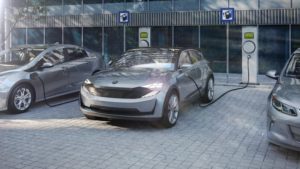We don’t yet have flying cars, but we may soon have electric cars powered by ocean rocks the size of potatoes.
 Those rocks represent a potentially game-changing solution to a looming metal shortage that could derail the burgeoning electric vehicles market. Global sales of electric vehicles are skyrocketing; there were 10 million EVs being driven around the globe at the end of 2020, according to the International Energy Agency. EV registrations also rose by 41 percent during the year, even as global car sales dropped by 16 percent. By 2030, the IEA projects that there will be between 145 and 230 million electric vehicles on the world’s roads.
Those rocks represent a potentially game-changing solution to a looming metal shortage that could derail the burgeoning electric vehicles market. Global sales of electric vehicles are skyrocketing; there were 10 million EVs being driven around the globe at the end of 2020, according to the International Energy Agency. EV registrations also rose by 41 percent during the year, even as global car sales dropped by 16 percent. By 2030, the IEA projects that there will be between 145 and 230 million electric vehicles on the world’s roads.
It’s an exciting prospect from an environmental standpoint. Relying more on electric vehicles should help us reduce our national demand for fossil fuels and cut down on emissions that damage public health and contribute to climate change. But as demand for EVs grows, so do metal shortages. The lithium-ion batteries that most EVs use are made with a combination of metals including nickel, cobalt, copper and manganese.
Supply is already decreasing for several battery metals, in part because the discovery of new mineral deposits has slowed over the last decade. Keeping up with the rising demand for these metals could be a major challenge for manufacturers.
Enter the ocean rocks.
Sourcing Ocean Floor Metals
In 1873, scientists aboard the HMS Challenger were near the beginning of a four-year-long deep ocean exploration. When they dredged the ocean floor, the members of the expedition found black oval rock-like objects that seemed to be composed of magnesium oxide.
It would be another century before the economic and environmental benefits of these mysterious objects became evident. Those scientists were the first to discover what we now call polymetallic nodules, or magnesium nodules. These nodules can be found sitting unattached on ocean floors around the world. (They can even be found in some lakes!) Researchers believe that these ocean floor metals were formed out of the metallic components that naturally exist in seawater, a process that took millions of years.
The exact chemical composition of polymetallic nodules varies based on where they formed, but they generally contain four of the metals that are essential for making batteries: cobalt, nickel, copper, and manganese.
The Plan to Use Polymetallic Nodules
In 2020, a Canadian company called DeepGreen released the results of research it had commissioned into the viability of using ocean floor metals as a source for EV batteries. Its findings suggested that deriving metals from nodules would create 70% less carbon dioxide equivalent emissions and 100% less solid waste than mining for metals on land, among other benefits. Then, in March of this year, DeepGreen announced it was merging with a special purpose acquisition company called the Sustainable Opportunities Acquisition Corporation to create The Metals Company, an entity whose sole focus will be mining ocean floor metals from polymetallic nodules.
The Metals Company now owns the rights to three exploration areas in the Pacific. Just a few weeks ago, the company unveiled its plan to collect and process nodules found in those exploration areas. A specially-designed robotic collector will be lowered to the ocean floor, where it will use jets of seawater to free nodules from any sediment. Then, nodules will be fed through a hose at the top of the collector vehicle and be lifted all the way to the surface (a distance of about 2.5 miles) on compressed air bubbles. They’ll be collected by a floating production vessel that runs on carbon-neutral electrofuels and is outfitted with solar panels. From there, nodules will be transferred to shuttle vessels that deliver them to portside processing plants.
TMC hopes to produce its first batteries by 2024, so we’ll be watching its progress closely. The company estimates that it will be able to extract enough ocean floor metals from the nodules found in its three exploration areas to produce as many as 280 million EV batteries by the year 2050. That’s about one quarter of the current number of passenger cars being driven around the world.
Electric Vehicles and Recycling
We don’t yet know how polymetallic nodules and other developments around EV batteries will affect metal recycling in the coming years. Widespread recycling of lithium-ion batteries could potentially help close the battery metal supply gap… but we’re not there yet. Only a fraction of lithium-ion batteries are currently recycled around the world. The process of recycling lithium-ion batteries is complicated, and the rise of EVs is so recent that recyclers are still working on finding cost-effective methods to reuse the metal components from these batteries.
Miller Recycling is here to meet all of your recycling needs, and to keep you informed about the recycling news that might affect your business today – or tomorrow. If you have questions about metal recycling or battery recycling, or need help streamlining your business’s recycling process, contact me today!

